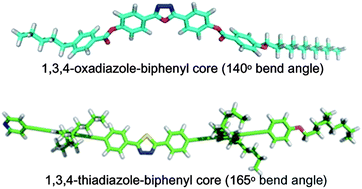The elastic and optical properties of a bent-core thiadiazole nematic liquid crystal are reported. The system exhibits unusually large values of birefringence (∼0.4), which can be partly attributed to significant conjugation in the molecular structure. It is found that the splay (K11), twist (K22) and bend (K33) elastic constants, determined from studies of the Freedericksz transition, satisfy K33 > K11 > K22 across the wide nematic range studied. Such behaviour is analogous to that commonly observed in calamitic nematic liquid crystals but is in contrast to all other bent-core nematic materials reported to date where it is found that K33 < K11. Such a result questions some of the current explanations that have been put forward to explain the elastic behaviour of bent-core materials. Using a molecular field theory, combined with DFT calculations of the molecular structure, we can ascribe the different elastic behaviour to the value of the bend angle in the molecular core. This angle is shown to play a subtle and substantial role in determining the physical properties of bent-core nematic liquid crystals.

You have access to this article
 Please wait while we load your content...
Something went wrong. Try again?
Please wait while we load your content...
Something went wrong. Try again?


 Please wait while we load your content...
Please wait while we load your content...